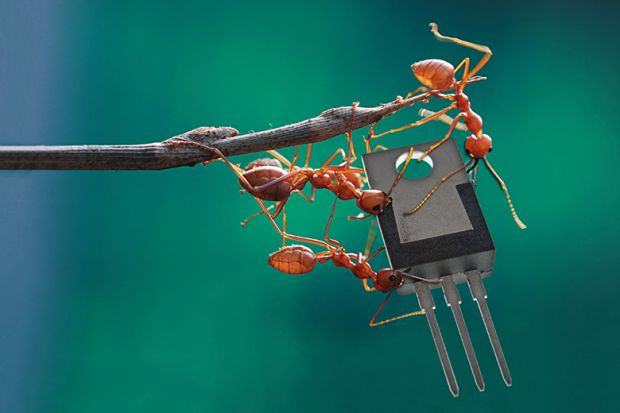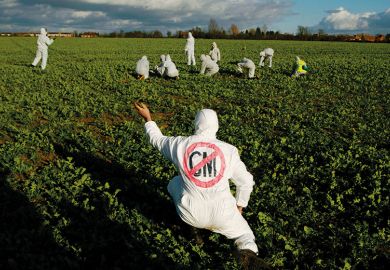In a 2006 article in the Hedgehog Review called “Invisible Science”, Steven Shapin started with McDonald’s and noted how that iconic company is impregnated with science at every pore: food production and safety, nutrition, packaging, advertising, customer relations…
In late modernism, science is everywhere, employing more than 4 per cent of the workforce, according to Shapin. Yet scientific research done in universities and related-research institutions employs only about 4 per cent of the science workers. If we go to the household names of science, Newton, Einstein, Planck, Crick and Watson, we will find that they make up an even smaller proportion of science – a fraction of a per cent of the 4 per cent of 4 per cent.
If we try to define science by what it does rather than its demographic penetration or its media representation, we could say that it comprises those activities that have a chance of producing exact solutions to problems in the foreseeable future. It represents a very small proportion of those activities that are inspired by this aim but do not actually deliver, such as those attempting to predict next year’s inflation and employment rates or the hours when it will be raining in London the week after next. Such activities driven by scientific aspirations swamp science in the narrow sense of the term because life is generally complex and chaotic, whereas the traditional icons of science dealt mostly with the simple and empty spaces of the very large or the very small.
Jeremy Baumberg is a successful scientist in the field of nanotechnology: professor at 30 and fellow of the Royal Society at 40. His chosen cross-section – the secret life from which he removes the lid – is the professional life of the research scientist and the institutions that support it: the publication system, the grant-giving system, the peer-review system, the refereeing system, the publicity system. It is great to see a professional scientist reflecting on these things. Richard Feynman notoriously, if inadvertently, pointed out that scientists do not need to know much about how science works in order to do it, but on the rare occasions when they do turn their attention to these matters, the result can be as good as or better than what philosophers, sociologists and historians produce. Baumberg is certainly up there when it comes to reflective description of the professional waters in which he swims.
This is a lively book filled with all manner of diverting sidelines: did you know that for every one of the 4 quadrillion ants on the Earth’s surface, we have made about 4,000 transistors? Yet I am going to concentrate on the part that focuses on the ever more feverishly growing level of activity in every sphere of research science. This is driven not by the desire to find out more about the natural world, but by professional careers and the desperate need to defend science and scientists within the hostile worlds of politics and free market economics.
What we see is a continual increase in the number of journals and the number of papers published. This is spurred by academics’ need to publish, to satisfy the requirements of agencies that rank university departments on their published output. At the same time, publishers are making an expanding fortune out of a business in which most of the work is produced, assessed and edited free for them. About half of the resulting output is never referred to by anyone and is probably never read by anyone except the author and the editors, while only a very small proportion makes any real impact. Baumberg suggests that the uncited stuff is important to save people saying the same thing again and again, although that seems less of an obstacle in the social sciences!
Meanwhile, we could all be publishing for nothing on the internet and, because of its speed, that is usually the way new results are promulgated in subjects such as physics. Ironically, the reason that we need ponderous, costly, old-fashioned print publishing is to create scarcity! If there were no way to limit what is officially worthy of publication, we would not be able to choose between candidates for academic posts and would find it even harder to select what to read from the overwhelming torrent of technical words. Baumberg is broadly optimistic about peer review as a limiter and judge for journals and grant agencies, but I think that there is more cause for concern in the social sciences.
The same kind of feverish story can be told for academic conferences, which are multiplying at such a rate that the successful scientist is travelling almost continuously – mostly to no scientific purpose. It is a pity that Arthur Koestler’s 1972 novel, The Call-Girls, does not get a mention. When we come to publicity, we find science shortened and oversimplified to get an audience, again both necessary and concerning. Baumberg points out that the best-selling science books are all by theorists. This troubles me, since many are virtually incomprehensible and this strand of science seems to be becoming part of a very peculiar entertainment industry, with large numbers of people desperate to have the equivalent of the Latin Bible on their shelves. Can that be good?
My own cross-section of science is different and, oddly for a sociologist, much more elitist than Baumberg’s. I have spent 45 years investigating the searchers after gravitational waves – whose leaders received the Nobel prize for the eventual discovery just last year. They stand, of course, not for themselves, but for scientists of a particular type. To my surprise and the scorn of my cynical colleagues in the social sciences, I have described them as potential leaders of democratic societies . The norms of scientific activities such as gravitational wave detection strongly overlap with democratic norms. Also, as has become painfully clear with the advent of Donald Trump’s fake news and alternative facts, scientific expertise is one of the moderating checks and balances needed to stop democracy declining into populism – the exercise of power justified as the expression of “the will of the people”. Remove the legitimacy from scientific expertise and political leaders are left free to decide for themselves what climate change means and whether vaccines are safe.
Science looked at in this way permeates the whole of society, not via McDonald’s and its products but with values and expertise that can provide some friction for politics. Baumberg’s description of science as answering to competition under capitalism is in tension with science as a bulwark of these values. That is why we need to read the book – not to find ways to make science a better servant of the economy but to consider how to preserve its central meaning in the face of political and economic pressure. After all, what use is all the economic success in the world if we live in a state that shamelessly grants the right of truth-making to the powerful? Science is even more important for what it is than for what it does. This is science’s heaviest burden.
Harry Collins is distinguished research professor in the School of Social Sciences, Cardiff University.
The Secret Life of Science: How it Really Works and Why it Matters
By Jeremy J. Baumberg
Princeton University Press, 248pp, £24.00
ISBN 9780691174358
Published 23 May 2018
The author
Jeremy Baumberg, professor of nanotechnology and photonics in the University of Cambridge’s Cavendish Laboratory, grew up in Leeds, close to the moors, and still feels his “deeper roots in Yorkshire, drawn to northern principles of pain before pleasure…as well as to the decaying industrial architecture of mills, canals, rust and stone, places I was desperate to leave for steel and glass science fiction but that now speak to my soul”.
As he recalls it now, Baumberg was “supremely lucky to get into Cambridge, despite my messing up science questions, because my interviewer ran the college music society and, at the time, I was intensely wedded to the piano, particularly the romantic and dramatic repertoire of Rachmaninov and Chopin. Studying natural sciences was profoundly important because it taught me not to be scared of disciplinary boundaries, which has guided my science since.”
Although always “interested in how we do what we do”, Baumberg decided to devote serious attention to “how science works” after becoming “increasingly puzzled by colleagues’ complaints about different parts of our science system, as well as annoyed at the universal media model for heroic scientists…An opportunity for a sabbatical in San Sebastián gave me the wonderful space to reflect and research.”
Asked about ways to improve the life of working scientists, Baumberg urges us to “reflect deeply on why we go to conferences, how we might rank them, and to invent gatherings that stimulate our imaginations and friendships while avoiding boring collectives of massive size. I have also become a strong advocate of creative anarchy – avoiding the relentless winnowing of diversity spread when adopting best practice throughout the science ecosystem – by starting new ways of doing things, of measuring things or funding things. I see that as my role now, of disruptive stimulation.”
Matthew Reisz
POSTSCRIPT:
Print headline: Inside the lab, a battle rages
Register to continue
Why register?
- Registration is free and only takes a moment
- Once registered, you can read 3 articles a month
- Sign up for our newsletter
Subscribe
Or subscribe for unlimited access to:
- Unlimited access to news, views, insights & reviews
- Digital editions
- Digital access to THE’s university and college rankings analysis
Already registered or a current subscriber?






